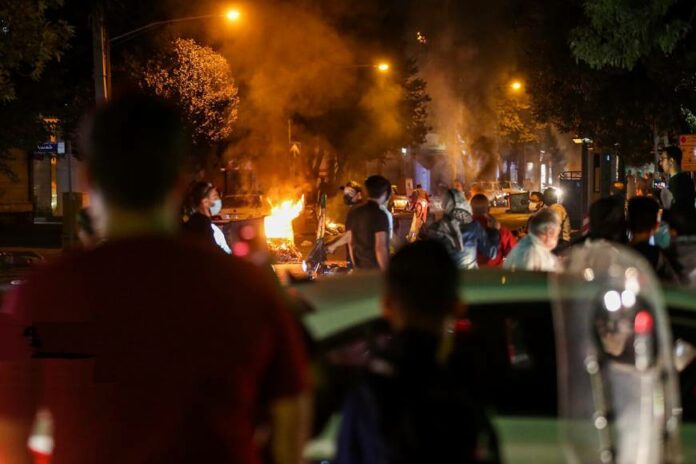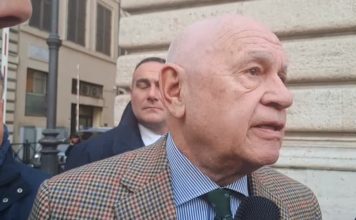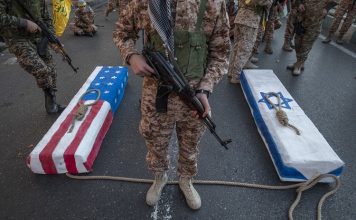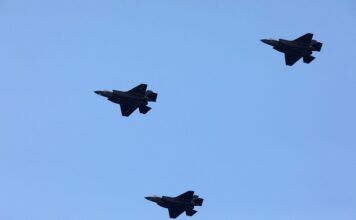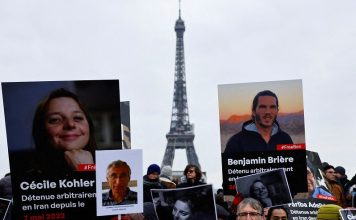Oct 20 (Reuters) – Two days before a fire ripped through a section of Iran‘s Evin prison and killed at least eight people, a riot police unit arrived at the compound and began to patrol the corridors, shouting “God is Greatest” and banging batons on cell doors, six sources told Reuters.
The patrols at the Tehran jail began without any apparent provocation by inmates, the sources said. These patrols continued from Thursday to Saturday, when some prisoners reacted by shouting for the downfall of Supreme Leader Ayatollah Ali Khamenei, echoing protests raging across Iran since September.
“Then we heard shots and chants of ‘Death to Khamenei’ by prisoners in other wards,” said an inmate inside ward 8, which holds mostly prisoners convicted of financial crimes.
Journalist Nazenin Ansari tells LBC the protest movement in Iran is 'not about anti-hijab, it's actually about pro-choice' and that the situation in the country is 'very tense'.@ShelaghFogarty | @NazeninA pic.twitter.com/hwjOgC1FoD
— LBC (@LBC) October 19, 2022
The prisoner, who was giving his account for the first time, spoke to Reuters on condition he was not named and that no mention was made of the method of communication.
The bloody crackdown by the police and the deadly fire on the evening of Oct. 15, whose origins are disputed, have shaken a society already on edge after a month of violence involving security forces and anti-government protesters.
Reuters interviews with the ward 8 prisoner, as well as a relative of an inmate and four rights activists with contacts at the prison suggest the inmates’ anti-government chants were a reaction to the police patrols and that police then responded forcefully to suppress them.
The prisoner and other sources spoke to Reuters on condition of anonymity due to concern for their safety.
Reuters was unable to determine why riot police were sent to the jail, what the government’s motives were for the crackdown and how the fire started. But it adds to a growing sense of the authorities’ determination to crush dissent and avoid losing control of Evin or other places that have been central to the Islamic Republic’s grip on society, four rights activists said.
WAVE OF UNREST
The prison, in Tehran’s Evin neighbourhood, has been the main site for holding prominent Iranian political prisoners, even before the 1979 Islamic revolution, as well as foreigners and dual nationals. It also holds inmates convicted of ordinary crimes, and is now receiving a stream of dissidents arrested in the continuing wave of unrest sweeping the country, Iranian authorities, prisoners families and lawyers say.
The prison is known as “Evin University” because of the many anti-government intellectuals and academics held there.
Eight prisoners died of smoke inhalation as a result of the fire, the judiciary said. Inmates and rights activists interviewed by Reuters feared more lives were lost. The assessment was based on the dozens of injured, many severely so, seen by the inmate and those prisoners in contact with the activists interviewed by Reuters.
Reuters sought comment from prison officials, the Interior Ministry and officials at the judiciary via telephone and by sending written text messages with questions regarding key points, including the account by sources about the deployment of riot police on Oct. 13. They have not responded.
But one Iranian official, who was reached by telephone but declined to be identified by name or the institution he worked for, said he did not know why the riot police were sent to the prison and expressed surprise the authorities seemed to have lost control of the facility for a time on Saturday evening.
One anti-government activist, speaking on condition of anonymity due to concerns for his security, told Reuters the government may have planned the prison crackdown in order to demonstrate to protesters the harsh form of detention that await them at Evin if they keep challenging the government.
As Many as 23 Children Killed During Iran Protests, UN Rights Office Says
‘LIKE A WAR ZONE’
Amnesty International said it had evidence, which it did not disclose, that the authorities sought to justify their bloody crackdown under the guise of battling the fire and preventing prisoner escapes.
The group also said prison officials and riot police repeatedly subjected many prisoners to brutal beatings with batons, particularly on their heads and faces.
The country was already tense on the evening of Oct. 15, when videos on social media showed a fire and plumes of smoke rising from the prison as gunshots rang out, and objects were seen being thrown into the complex.
Around the country, security forces were struggling to contain nationwide demonstrations triggered by the death last month of 22-year-old Kurdish Iranian woman Mahsa Amini while in the custody of Iran‘s morality police.
On the night of the fire, state media reported that a group of prisoners were trying to escape, and had stepped on a minefield outside the complex.
This version was denied on Sunday by the judiciary, which said a prison workshop had been set on fire at mid-evening on Saturday “after a fight among a number of prisoners”.
The prisoner and activists said no inmates could have been at the workshop in mid-evening, because they would have been locked in at that time. Evin’s cells are shut between 5 and 6 p.m., depending on prayer time.
Reuters could not independently determine what triggered the blaze.
‘EVERYONE WAS SCARED’
Tensions rose when inmates, provoked by the riot police chanting religious slogans and hammering batons on cell doors, responded with “Death to Khamenei”. Then, at about 8 p.m., shots were fired by the riot police, sources said.
“When we heard shots and chants, we tried to break the door and get to the corridor to help other prisoners from ward 7 who broke the door and were clashing with the riot police and prison guards in the corridor. Everyone was scared,” said the inmate.
Ward 7 holds prisoners convicted of general crimes and political prisoners, and is in the same building housing ward 8. Riot police and prison guards fired teargas and metal pellets at hundreds of prisoners and beat people with batons, according to Reuters interviews with the prisoner, the relative of an inmate and activists with contacts at the prison.
“They opened the door of our ward (8) and were shooting at us with pellet guns. Fired tear gas. Dozens, dozens of them were there. Many people in our ward were injured and could not breathe,” said the prisoner.
“We could hear gunshots, prisoners were screaming, guards were shouting, they opened the door and threw so much tear gas inside and used pellet guns. Many inmates fainted, dozens were injured. It was like a war zone,” he added.
Human rights activist Atena Daemi, who was jailed in Evin for 5-1/2 years and was released nine months ago, has kept in contact with detainees there.
“Prisoners from ward 7 tried to break the door of ward 8 to let them out too. It is when the forces started shooting at the prisoners around 20:30 with live ammunition,” she said.
Neither state media nor the judiciary have disclosed the methods police used to retake control at Evin.
Mehdi Rafsanjani, the son of a former president, who is serving a 10-year sentence for financial corruption in Evin and normally has a weekly furlough Wednesday-to-Friday, was told on Wednesday Oct. 12 he should return to the prison only after Saturday, his brother Yasser Hashemi Rafsanjani said on a social media platform.
“My brother Mehdi was told not to come back until after Saturday,” he said, adding his brother was given no explanation and was now back in prison.
SPECIAL REPORT- Iran’s Leader Ordered Crackdown on Unrest: “Do Whatever It Takes to End It”
Iran Accused of “Crimes Against Humanity” at Aban Tribunal in London
(Writing by Michael Georgy; Editing by William Maclean and Edmund Blair)

